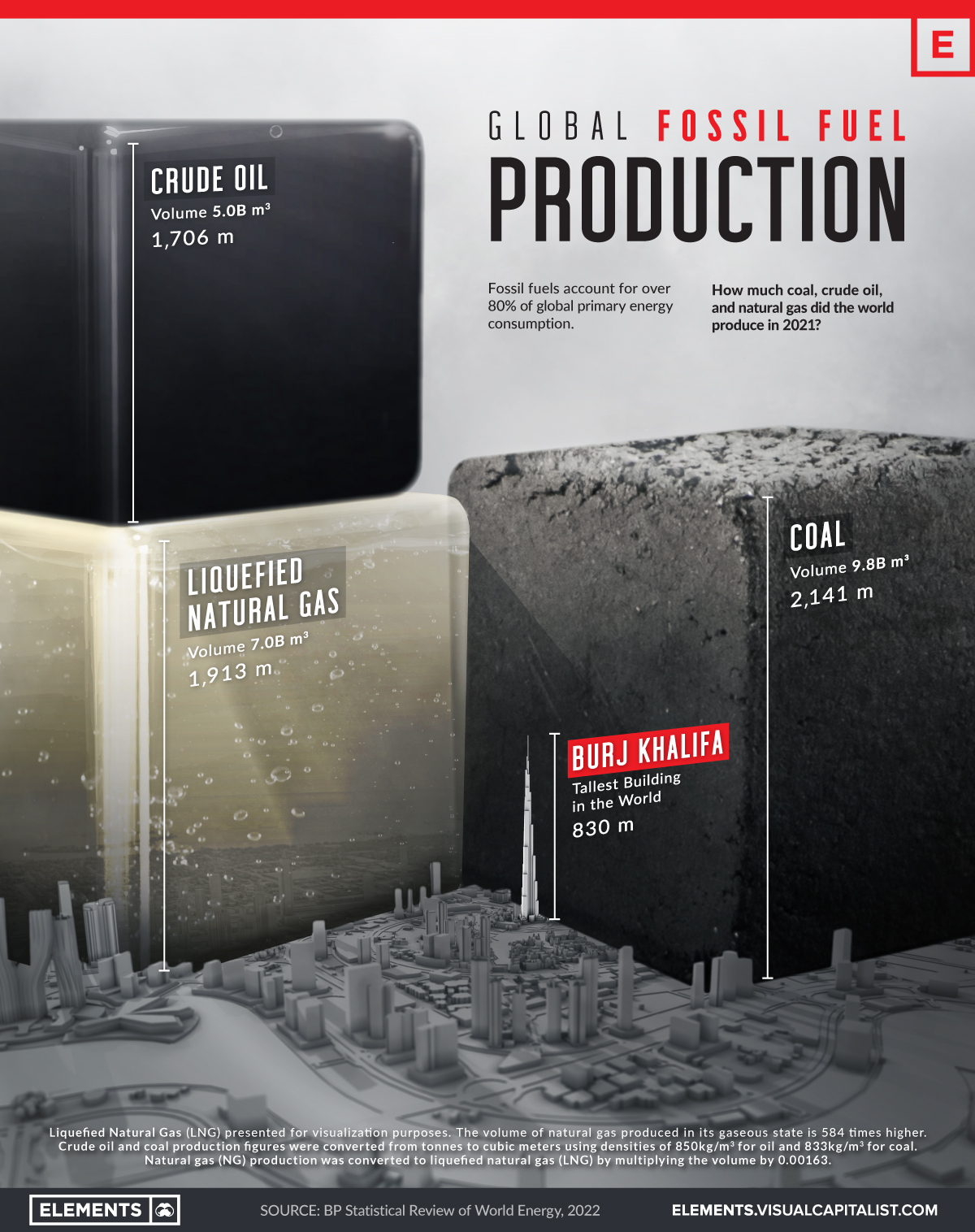
Subscribe to the Elements free mailing list for more like this
The Scale of Global Fossil Fuel Production
This was originally posted on Elements. Sign up to the free mailing list to get beautiful visualizations on natural resource megatrends in your email every week.
Fossil fuels have been our predominant source of energy for over a century, and the world still extracts and consumes a colossal amount of coal, oil, and gas every year.
This infographic visualizes the volume of global fossil fuel production in 2021 using data from BP’s Statistical Review of World Energy.
The Facts on Fossil Fuels
In 2021, the world produced around 8 billion tonnes of coal, 4 billion tonnes of oil, and over 4 trillion cubic meters of natural gas.
Most of the coal is used to generate electricity for our homes and offices and has a key role in steel production. Similarly, natural gas is a large source of electricity and heat for industries and buildings. Oil is primarily used by the transportation sector, in addition to petrochemical manufacturing, heating, and other end uses.
Here’s a full breakdown of coal, oil, and gas production by country in 2021.
Coal Production
If all the coal produced in 2021 were arranged in a cube, it would measure 2,141 meters (2.1km) on each side—more than 2.5 times the height of the world’s tallest building.
China produced 50% or more than four billion tonnes of the world’s coal in 2021. It’s also the largest consumer of coal, accounting for 54% of coal consumption in 2021.
| Rank | Country | 2021 Coal Production (million tonnes) |
% of Total |
|---|---|---|---|
| #1 | China | 4,126.0 | 50% |
| #2 | India | 811.3 | 10% |
| #3 | Indonesia | 614.0 | 8% |
| #4 | U.S. | 524.4 | 6% |
| #5 | Australia | 478.6 | 6% |
| #6 | Russia | 433.7 | 5% |
| #7 | South Africa | 234.5 | 3% |
| #8 | Germany | 126.0 | 2% |
| #9 | Kazakhstan | 115.7 | 1% |
| #10 | Poland | 107.6 | 1% |
| Other | 600.9 | 7% | |
| Total | 8,172.6 | 100% |
India is both the second largest producer and consumer of coal. Meanwhile, Indonesia is the world’s largest coal exporter, followed by Australia.
In the West, U.S. coal production was down 47% as compared to 2011 levels, and the descent is likely to continue with the clean energy transition.
Oil Production
In 2021, the United States, Russia, and Saudi Arabia were the three largest crude oil producers, respectively.
| Rank | Country | 2021 Oil Production (million tonnes) |
% of Total |
|---|---|---|---|
| #1 | U.S. | 711.1 | 17% |
| #2 | Russia | 536.4 | 13% |
| #3 | Saudi Arabia | 515.0 | 12% |
| #4 | Canada | 267.1 | 6% |
| #5 | Iraq | 200.8 | 5% |
| #6 | China | 198.9 | 5% |
| #7 | Iran | 167.7 | 4% |
| #8 | UAE | 164.4 | 4% |
| #9 | Brazil | 156.8 | 4% |
| #10 | Kuwait | 131.1 | 3% |
| Other | 1172.0 | 28% | |
| Total | 4221.4 | 100% |
OPEC countries, including Saudi Arabia, made up the largest share of production at 35% or 1.5 billion tonnes of oil.
U.S. oil production has seen significant growth since 2010. In 2021, the U.S. extracted 711 million tonnes of oil, more than double the 333 million tonnes produced in 2010.
Natural Gas Production
The world produced 4,036 billion cubic meters of natural gas in 2021. The above graphic converts that into an equivalent of seven billion cubic meters of liquefied natural gas (LNG) to visualize it on the same scale as oil and gas.
Here are the top 10 producers of natural gas in 2021:
| Rank | Country | 2021 Natural Gas Production (billion m3) |
% of Total |
|---|---|---|---|
| #1 | U.S. | 934.2 | 23% |
| #2 | Russia | 701.7 | 17% |
| #3 | Iran | 256.7 | 6% |
| #4 | China | 209.2 | 5% |
| #5 | Qatar | 177.0 | 4% |
| #6 | Canada | 172.3 | 4% |
| #7 | Australia | 147.2 | 4% |
| #8 | Saudi Arabia | 117.3 | 3% |
| #9 | Norway | 114.3 | 3% |
| #10 | Algeria | 100.8 | 2% |
| Other | 1106.3 | 27% | |
| Total | 4,036.9 | 100% |
The U.S. was the largest producer, with Texas and Pennsylvania accounting for 47% of its gas production. The U.S. electric power and industrial sectors account for around one-third of domestic natural gas consumption.
Russia, the next-largest producer, was the biggest exporter of gas in 2021. It exported an estimated 210 billion cubic meters of natural gas via pipelines to Europe and China. Around 80% of Russian natural gas comes from operations in the Arctic region.
The post Visualizing the Scale of Global Fossil Fuel Production appeared first on Visual Capitalist.